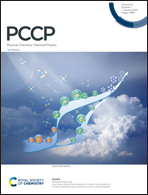Relationship between the electron-transfer coefficients of the oxygen reduction reaction estimated from the Gibbs free energy of activation and the Butler–Volmer equation†
Abstract
The rate of electron-transfer reactions, irrespective of whether electrochemical or electrocatalytic, is universally explained on the basis of Butler–Volmer (B–V) theory. The charge-transfer coefficient (α) obtained is typically in the range of 0.0–1.0, and is 0.6 ± 0.1 for the oxygen reduction reaction (ORR) on Pt, which is the subject of the present investigation. Alternatively, α can be estimated from the derivative of the change in Gibbs free energy of activation (ΔG#) with respect to the overpotential (η) and has the unreasonably high value of 1.1 ± 0.2. The origin of the difference in the α values obtained from these two methods is investigated. The value of α greater than 1.0 stems from the alternative potential-dependent lower energy barrier path for the formation of the activated complex, offered by the electrified catalyst surface. For the electrocatalytic reaction, the α value derived from the ΔG# is the true kinetic parameter. The theoretical background of such processes is presented to justify our claims.



 Please wait while we load your content...
Please wait while we load your content...